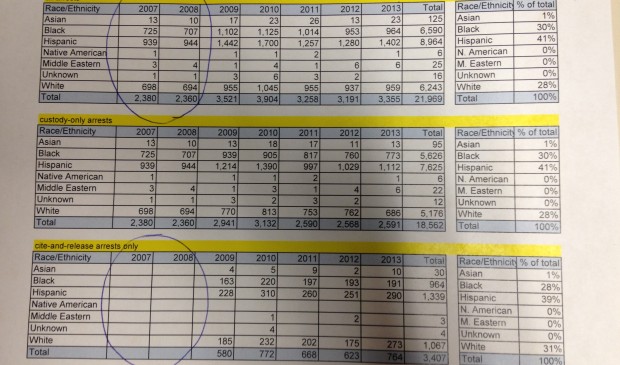Police claim no disparities in marijuana arrests
Tuesday, September 2, 2014 by
Kara Nuzback Austin police say African-Americans are not unfairly targeted by police for marijuana offenses, despite community claims to the contrary. The Austin Human Rights Commission met last week to hear a presentation from Assistant Police Chief Brian Manley about statistics related to citations for marijuana, as opposed to arrests.
Manley said of all the Austin Police Department arrests for marijuana from 2007 to 2013, 30 percent of those arrested were black, 41 percent were Hispanic and 28 percent were white. According to the 2010 Census, Austin’s overall ethnic breakdown is 47.8 percent white, 7.7 percent African-American and 35.1 percent Hispanic.
Manley said in 2009, the city adopted a policy to cite and release anyone found with less than 4 grams of marijuana, rather than arrest and take them into custody. He said police are only authorized to arrest a person with less than 4 grams if the person has a history of failing to appear in court or if the arresting officer receives approval from a supervisor to make the arrest.
“We expect our officers to employ cite and release whenever possible,” Manley said.
Commissioner DeWayne Lofton said the commission heard otherwise from members of the community.
Commission Vice Chair Sara Clark said the commission took up the issue because in 2012, the police department received a public information request from Austin resident Colin Clark asking for the number of people arrested for marijuana possession, the number of people cited for possession and the race of those cited or arrested.
In an April 4, 2012, response, Colleen Waters, APD’s administrative manager, provided the number of people charged with possession of marijuana by race from 2007-2011, but she said the department did not track the number of citations versus the number of arrests. At the meeting, Sara Clark said that led the commission to question whether a racial disparity exists in marijuana arrests.
Manley said it is likely the department began separately tracking arrests and citations after the 2012 public information request. But police statistics show consistency, rather than disparity, in marijuana arrests and citations, he said.
Since APD adopted its cite and release policy in 2009, 28 percent of the citations went to African-Americans, 31 percent to whites and 39 percent to Hispanics, he said.
Manley’s statistics showed that of the 3,355 arrests for marijuana possession in 2013, the vast majority — 2,591 — led to arrests, while only 764 of those charged were given a citation and released. Most marijuana arrests are combined with other charges, Manley said, so a citation and release is an option only about a quarter of the time.
The commission took no action with regard to the APD statistics, and members did not say whether they would revisit the issue at a future meeting.
In an email after the meeting, Vice Chair Clark asked Manley what technology the APD adopted since April 2012 that now allows it to track citations separately from arrests. She also noted that Manley’s inclusion of data in 2007 and 2008, before the APD adopted its cite and release policy, seemed to “water down” the data when comparing citations to arrests over the six-year period.
Further, she asked Manley if it were possible to exclude from his data marijuana arrests that occurred in conjunction with other charges for which an arrest was required.
As of Friday, Manley had acknowledged receiving the query but had not specifically responded to Clark’s questions.
You're a community leader
And we’re honored you look to us for serious, in-depth news. You know a strong community needs local and dedicated watchdog reporting. We’re here for you and that won’t change. Now will you take the powerful next step and support our nonprofit news organization?



